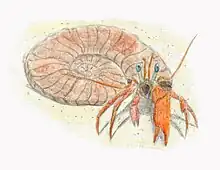| Palaeopagurus Temporal range: | |
|---|---|
 | |
| Life restoration | |
| Scientific classification | |
| Kingdom: | |
| Phylum: | |
| Subphylum: | |
| Class: | |
| Order: | |
| Superfamily: | |
| Family: | |
| Genus: | Palaeopagurus Van Straelen, 1925[1] |
| species | |
| |
Palaeopagurus is an extinct genus of hermit crab from the Lower Cretaceous.
A fossil of the species P. vandenengeli is notable for having been preserved in situ in the shell of an ammonite. Along with a lack of fossils of hermit crabs in gastropod shells from before the Late Cretaceous, this suggests that ammonite shells may have played a more important role in the early evolution of hermit crabs' characteristic shell-dwelling habits.[1]
References
- 1 2 René H. B. Fraaije (2003). "The oldest in situ hermit crab from the Lower Cretaceous of Speeton, UK". Palaeontology. 46 (1): 53–57. doi:10.1111/1475-4983.00286.
This article is issued from Wikipedia. The text is licensed under Creative Commons - Attribution - Sharealike. Additional terms may apply for the media files.